When you’re about to spend two weeks in the Kimberley and you need a partner in crime, it’s generally not too hard to find a willing volunteer. Having not yet ticked the Kimberley off her bucket list, my best mate Bec snapped to attention and in no time we were flying across the country to Perth, along with our friend Hayden and his many kilos of camera gear. With the hardfloor Skamper Kampers Dingo affixed to the rear of the Isuzu MUX that would serve as our dutiful steed for the trip, we finally headed north and let Perth slip quietly away in the rear view mirror.
ALL ROADS LEAD NORTH
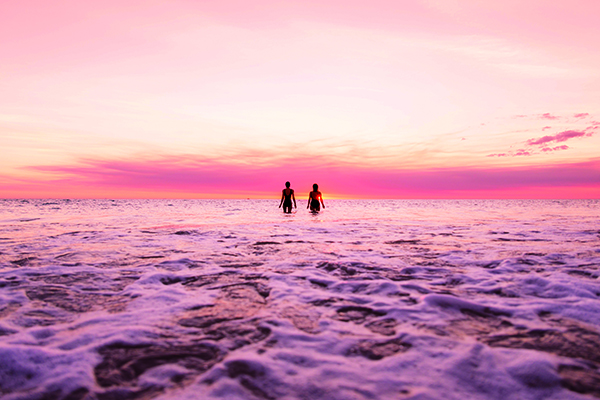


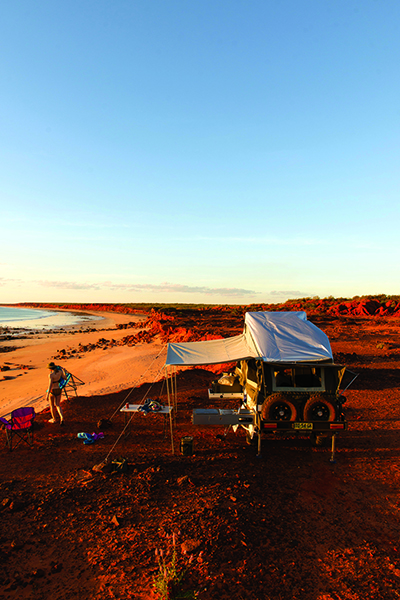
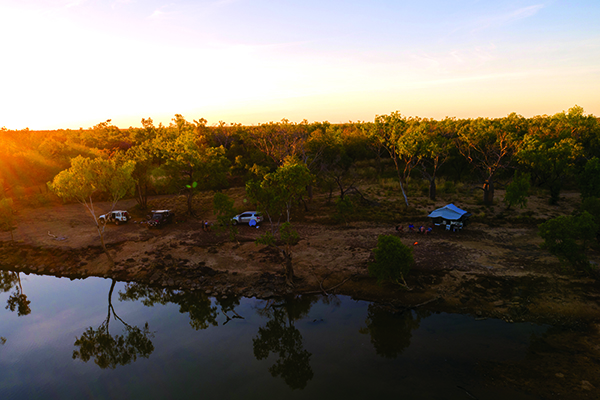

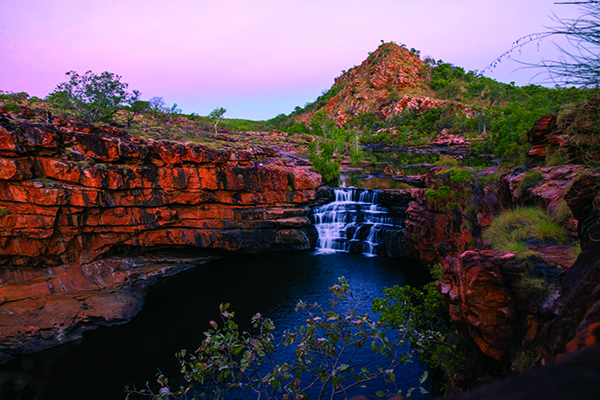
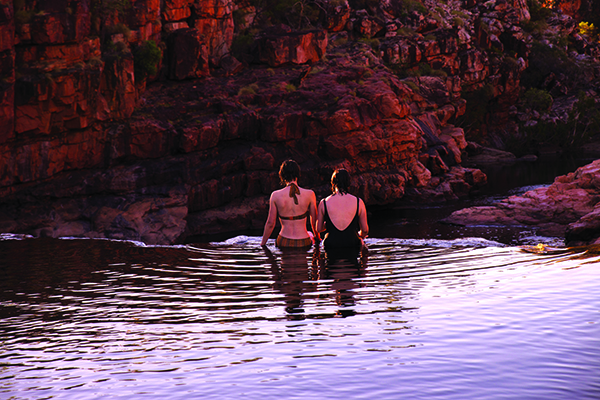
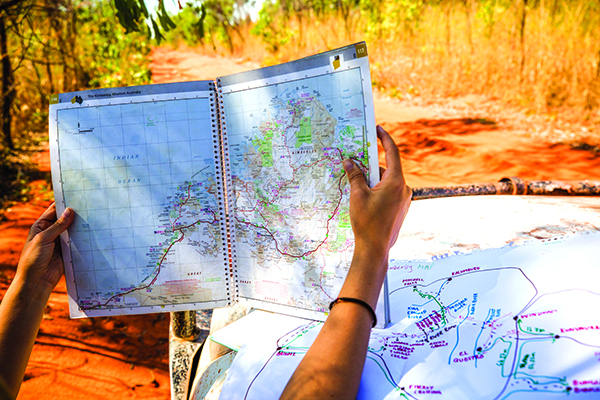
A few hundred songs and several roadside schnitzels later and we eventually rolled into Broome and straight down onto the compacted sands of Cable Beach for a dip as the sun sank into the Indian Ocean. Winter who?
From there we decided to avoid the popular Cape Leveque and instead opted for the equally epic James Price Point (JPP), traditionally known as Walmadany, only a couple of hours up the peninsula from Broome. We of course took the scenic route, checking out pristine white sandy beaches and weaving through the dry Kimberley scrub before arriving at our destination. And holy shit, what a place.
James Price Point typifies the concept of ‘where the outback meets the sea’. It’s comprised of a vast, blood red rock shelf that tapers down to pristine white sandy beaches and shallow rock pools, beyond which the Indian Ocean glimmers in iridescent aquamarine. Pink mulla mulla flowers fringe the top of the incredible wave-like structure of the rock shelf, rusted to deep red hues over the millennia. And this place sure is ancient; the rock shelf is home to the prehistoric footprints of 21 different species of dinosaur, including some of the largest footprints ever found at 1.7m.
After exploring the coastline of JPP we were keen to ditch the wind, by far the worst of the elements, in my opinion, and head inland. We stocked up on supplies in Derby and hit the Gibb River Road headed for Kimberley Downs Station. It’s not signposted so most tourists simply drive straight past, but this spot was something special. Located on the May River, it’s a series of peaceful waterholes with sandy beaches linked by gently cascading waterfalls with the odd freshwater croc and an abundance of iconic Kimberley boab trees.
CAMPED BY A BILLABONG
We found ourselves the perfect spot to camp beside a deep, cool waterhole beneath a couple of boabs and set up camp for the next few days. This spot was too good to pack up and leave after only one night and we were just a stone’s throw from Windjana Gorge and Tunnel Creek, so planned to daytrip to check them out the following day.
Leaving our friend the Dingo behind for the day, we packed our lunch and set out for a daytrip to Windjana Gorge and Tunnel Creek, about an hour up the road. Windjana was first on the list, and we were not disappointed. Comprised of an ancient Devonian-era reef split down the middle by the meandering Lennard River, Windjana Gorge stretches for 3km and offers a very pretty, easy walk across mostly flat terrain alongside the river. Sandwiched by sheer 100m cliffs in streaky hues of orange, pink and charcoal, the riverbanks are verdantly forested and home to swarms of noisy native birds. Freshwater crocs are everywhere you look, sunning themselves on the vast sandy beaches and skulking lithely through deep pools. Windjana is not the place for a swim, methinks.
Further up the road, Tunnel Creek provided a unique experience indeed, necessitating sandshoes without socks and a decent quality head torch. The walk is not for the fainthearted, traversing through the shallow water of an underground creek flowing through a spectacular network of caves. By the light of your head torch you might spot the beady red eyes of a freshwater croc or the disorientating flurry of a bat’s wings as your head bobs sometimes just a few feet from her rooftop home. At intervals the cave opens to the heavens, allowing sunlight to cascade down in shafts. The contrast with the dark, ominous cave is otherworldly; crumbling ancient rock walls give way to lush greenery. Kodak moments literally everywhere you look; Tunnel Creek was a trip highlight for sure.
OUTBACK OASIS
Next stop, Bell Gorge. After a particularly scenic stretch of the Gibb River Road where it weaves through the crumbling ruins of the ancient King Leopold Ranges, we steered the good ship Dingo off the main drag towards this most beloved Kimberley treasure. The dirty dog got to cool its gills in more than a couple of creek crossings on the way in; lush little patches of watery bliss amidst an otherwise dry, dusty landscape.
Belle is the French word for beautiful and as such I really think they should have wacked an extra ‘e’ on the end of Bell in this context, although beautiful is probably an understatement. Bell Gorge is like an artist’s impression of the ultimate outback oasis, almost impossibly perfect. Smooth, dusty pink rock fringed with tropical foliage frames serene pools of crystal clear water that pushes slowly but surely toward the falls. Below, an enormous deep pool rewards those who opt for an extended hike around the rugged cliffs to reach it. We arrived in the late afternoon and frolicked for several hours until rich golden light washed the landscape a hazy shade of pink. We had the place to ourselves by then, and it was not lost on us. Pressed against the smooth, slippery cusp of the waterfall – nature’s infinity pool – I gazed dreamily out across the vast landscape below. Getting to experience moments and places like this are what make an offroad-capable camper trailer like the Dingo worth every penny.
KIMBERLEY PACKING CHECKLIST
- A set of MaxTrax or two – the coastal Kimberley is a 4WD heaven but that fluffy white sand can ensnare gung-ho drivers.
- A recovery kit. The main arteries are good quality but some of the best destinations are down hard-to-access tracks. Be prepared.
- Jerry cans for extra fuel and drinking water.
- A hiking daypack for lunch, water, sunscreen and your bathers.
- A quality 4WD map. We like Hema’s Kimberley folding map, or even better, the brand’s new HX-1 GPS offroad navigating system.
- An air-compressor. From beaches to corrugations, you'll be switching your pressures up a lot.
- A satellite phone or high frequency radio and a GPS personal locator / tracking device for emergency communications.
- Enough food to last until the next major shop – grocery items in remote parts of the Kimberley are very expensive and fresh produce can be hard to come by, so stock up in the more major centres of Derby, Broome or Kununurra.
- A shovel. Plenty of self-sufficient camping here; do the right thing and dig a deep hole well away from camping areas, and ALWAYS bury toilet paper.
- Fishing gear – from the coast to the inland waterways, fishing here is outrageously good.




